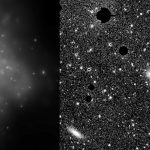A physicist making great advances in particle detector technology, Estrada is recognized by the American Physical Society Division of Particles and Fields for his creation and development of novel applications for CCD technology that probe wide-ranging areas of particle physics, including cosmology, dark matter searches, neutrino detection and quantum imaging.
dark matter
From UChicago News, Feb. 12, 2021: Fermilab scientist Yuanyuan Zhang discusses the implications of the studies she led on intracluster light using Dark Energy Survey data, which may include a new way of measuring dark matter.
From Forbes, Feb. 12, 2021: In June 2020, results from an experiment located in Italy suggested that dark matter may have been directly observed. Another experiment, conducted in China, has announced consistent data. Has dark matter been discovered? Fermilab scientist Don Lincoln explains why we’ll only know in retrospect using the next generation of detectors.
From Universe Today, Feb. 3, 2021: Recent published results from the Dark Energy Survey point to intracluster light — feeble light from rogue stars that don’t belong to a galaxy — as a potential pathway to measure dark matter. Fermilab scientist Yuanyuan Zhang contextualizes the findings.
From Super Interessante, Jan. 31, 2021: A team of researchers from Fermilab and the National Observatory in Brazil used the light of solitary stars to calculate the mass of some of the largest structures in the cosmos — galaxy clusters. In addition to taking the most detailed measurement ever published of intracluster light, the team’s new method of measurement can help further investigate dark matter.
From University of Birmingham, Jan. 13, 2021: Fermilab will take part in an international collaboration, led by Cardiff University, on quantum-enhanced interferometry for new physics. The project’s four table-top experiments may help explore new parameter spaces of photon-dark matter interaction, and seek answers to the long-standing question at the heart of modern science: How can gravity be united with the other fundamental forces?
From University of Strathclyde-Glasgow, Jan. 13, 2021: Fermilab will take part in an international collaboration, led by Cardiff University, on quantum-enhanced interferometry for new physics. The project’s four table-top experiments may help explore new parameter spaces of photon-dark matter interaction, and seek answers to the long-standing question at the heart of modern science: How can gravity be united with the other fundamental forces?
From New Scientist, Jan. 25, 2021: The Big Bang left us the universe — and a major set of mysteries around antimatter, dark matter, dark energy, and cosmic inflation. While the Large Hadron Collider looks at what the laws of physics were like a trillionth of a second after the Big Bang, Dan Hooper, head of theoretical astrophysics at Fermilab, thinks the answers to these puzzles may depend on better understanding that first fraction of a second — even closer to the universe’s beginning.
From University of Glasgow, Jan. 13, 2021: Fermilab will take part in an international collaboration, led by Cardiff University, on quantum-enhanced interferometry for new physics. The project’s four table-top experiments may help explore new parameter spaces of photon-dark matter interaction, and seek answers to the long-standing question at the heart of modern science: How can gravity be united with the other fundamental forces?
Faint light from rogue stars not bound to galaxies has been something of a mystery to scientists. The dimness of this intracluster light makes it difficult to measure, and no one knows how much there is. Scientists on the Dark Energy Survey, led by Fermilab, have made the most radially extended measurement of this light ever and have found new evidence that its distribution might point to the distribution of dark matter.


